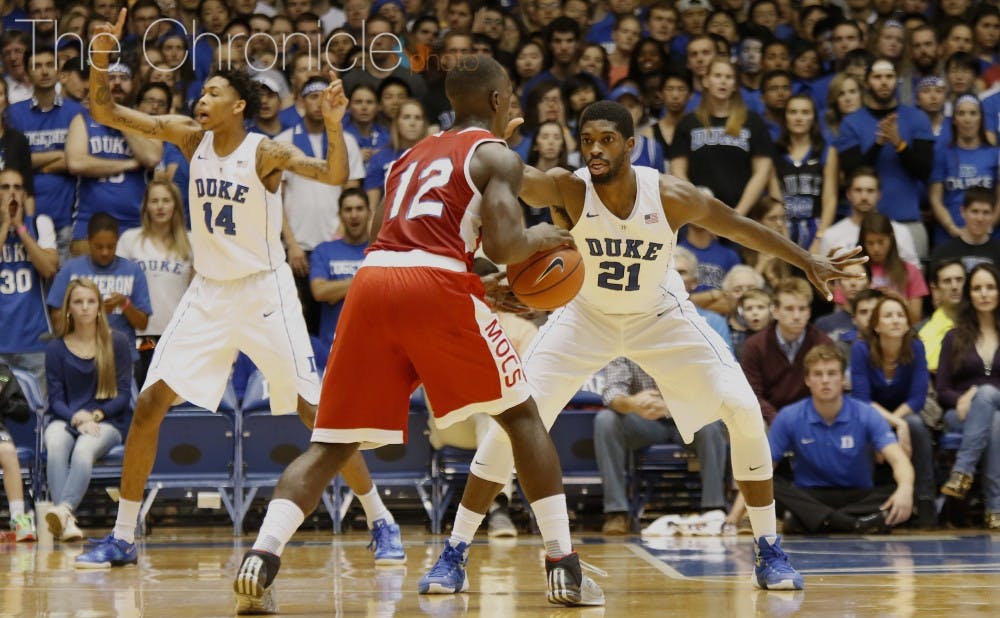When Amile Jefferson went out with a foot injury Dec. 14, it was evident that Duke’s season had just taken a major detour.
Through the team’s first nine games, the senior forward had proven to be the Blue Devils’ most reliable player. Jefferson was ably filling a hole in the team’s most obvious area of need—frontcourt weapons—with a double-double average of 11.4 points and 10.3 rebounds per game. At the time of his injury, Jefferson was leading the team with a 68.3 field goal percentage and ranked fifth in the country with 4.8 offensive boards per game.
With an offensive game centered around crashing the glass and converting misses into easy buckets, the Philadelphia native was the rare offensive player who could score without ever really needing the ball. This allowed the Blue Devils to keep the ball in the hands of their talented backcourt, and create more first-shot opportunities for the likes of Brandon Ingram and Grayson Allen.
And as effective as Jefferson was offensively, he provided even more value for Duke as its undisputed vocal leader on the defensive end of the floor. At 6-foot-9, he presented formidable post defense and had the length to stretch the floor on screens or at the top of various zone schemes head coach Mike Krzyzewski employed from time to time.
It’s now been more than a month since Jefferson was sidelined, and with a speedy return unlikely, it’s time to look at the post-Jefferson version of these Blue Devils. This week’s three-game losing streak—the eight, ninth and 10th contests Duke has played without its senior captain—put the team’s record at 6-4, as opposed to the 8-1 ledger it compiled with Jefferson on the floor.
Not surprisingly, Jefferson’s absence has been felt the most in the rebounding department. Krzyzewski immediately shifted to a four-guard lineup of sorts—sliding the 6-foot-9 Ingram to the four slot as a makeshift power forward—that left the Blue Devils short-handed on the glass.
In its first nine games, Duke posted an average rebounding margin of plus-6.6, and outrebounded every one of its opponents. The last 10 games tell a vastly different story—the Blue Devils have been outrebounded in all four losses during this stretch and six times overall, including three by double-digits. Duke’s defensive rebounding percentage has dropped by more than three percentage points—meaning opponents (like Tyler Roberson and his 12 offensive rebounds Monday) are getting better at grabbing their own misses. The Blue Devils have also pulled down 1.6 fewer offensive boards per game, exactly the phase of the game Jefferson excels in.
As Ingram’s spot in the starting lineup shifted, so too, has his production. The Kinston, N.C., native’s minutes have increased drastically from 26.9 to 35.8 since Jefferson’s injury—the biggest increase of any player—and Ingram is grabbing more than three additional rebounds per game. Duke’s four-guard set in many ways tailors to Ingram’s strengths offensively, as it gives the lengthy swingman more space to take defenders out to the perimeter and drive to the rim.
Whether it be a result of the smaller lineup or simply adjusting to the college game, Ingram’s offensive production since the injury has skyrocketed—19.3 points per game on 50 percent shooting, as compared to 13.7 points per game on 45 percent shooting before Jefferson’s injury.
The second-biggest minutes increase has gone to freshman Luke Kennard, who was inserted into the starting lineup in Jefferson’s first missed game against Georgia Southern, and again Saturday against the Fighting Irish. Kennard’s playing time has bumped up from 20.2 minutes per game to 28.5—and, like Ingram, his production has climbed as well.
At the beginning of the season, Kennard struggled to find his shooting rhythm and shot 30 percent or worse in five of his first nine games. Since Jefferson’s injury, though, the Franklin, Ohio, native has transformed into an efficient offensive force—save Monday’s 0-for-9 debacle against the Orange—shooting better than 45 percent from the field, increasing his scoring to 15.3 points per game from 8.9, and pulling down more than twice as many rebounds.
Down in the post, Marshall Plumlee has had to adjust to being the only true big to see significant minutes, but his numbers have spiked too—6.2 additional minutes per game, accompanied by 4.7 more points, 2.9 more rebounds per contest and an eight-point bump in field goal percentage.
Ingram, Kennard and Plumlee have all gotten more minutes and been more productive—on a per minute played basis—since Jefferson’s injury five weeks ago, yet the Blue Devils have picked up four of their five losses with him on the bench. Why is that?
Allen and Matt Jones have seen their shooting numbers dip slightly, and both are averaging more than 35 minutes per game since mid-December. Both guards are considered veterans on this young Duke team and Krzyzewski puts a lot of trust in them, but they haven’t quite been able to pick up the slack in crunch time.
Neither Chase Jeter nor Sean Obi has not been able to step up as a solid second big off the bench—Jeter has just nine points against 21 fouls in 72 minutes since Jefferson went out—and Duke has faced a string of very good power forwards in the likes of Jakob Poeltl, Devin Thomas, Zach LeDay, Jaron Blossomgame and Bonzie Colson. Plumlee’s offensive numbers may have increased, but the lack of a quality backup means he has to be more cautious on the defensive end to avoid fouls—a reality other teams have quickly exploited by attacking the paint and the offensive glass.
Then there’s the reality that the Blue Devils are basically functioning with a six-man rotation, which causes an incalculable amount of fatigue and slippage in play. Tiredness combined with a lack of frontcourt size is a recipe for a team to be dominated on the glass—and that’s precisely what happened in each of Duke’s three losses this week.
Get The Chronicle straight to your inbox
Signup for our weekly newsletter. Cancel at any time.

